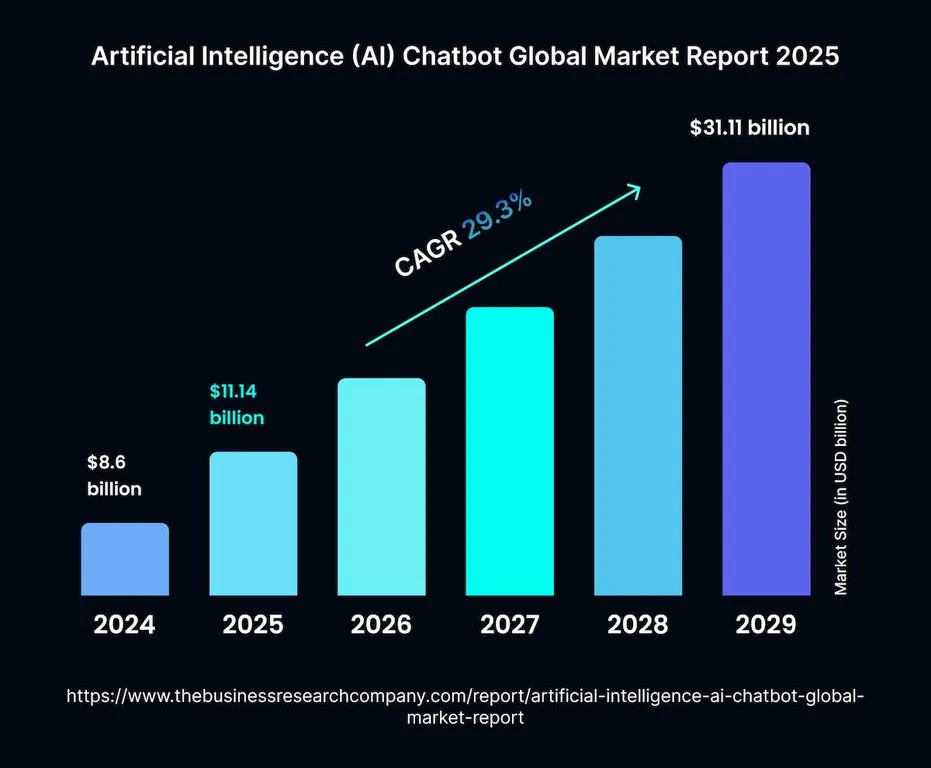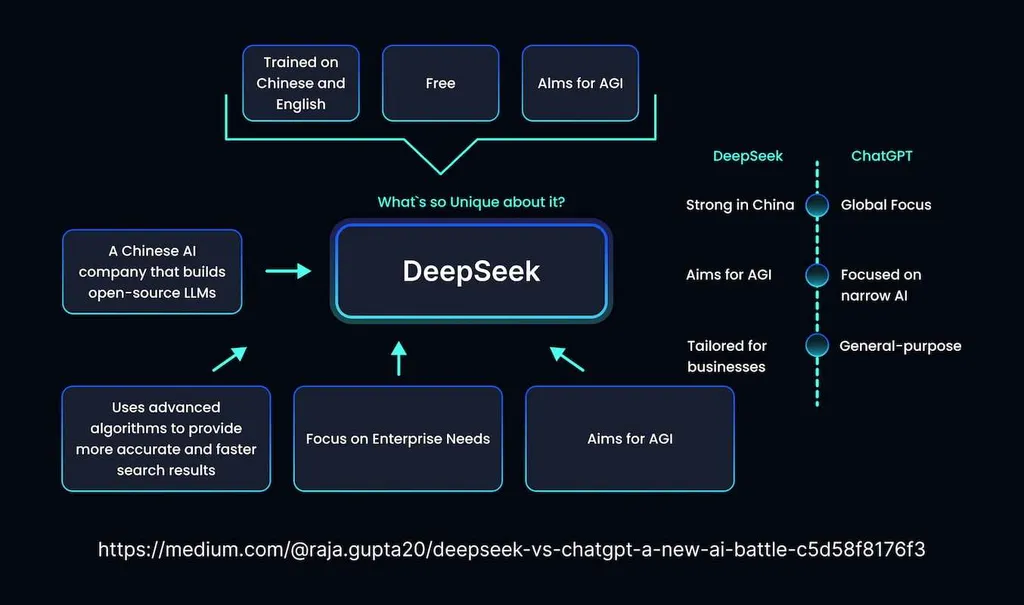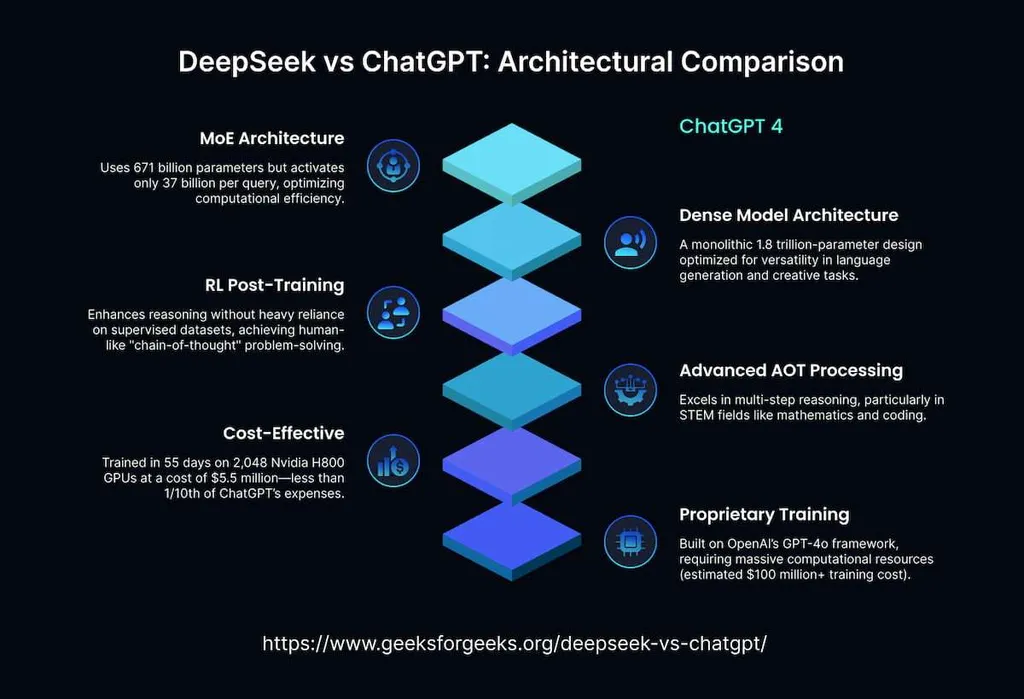Artificial intelligence is discussed a lot these days. It’s mentioned on TV, on the Internet, and in technical chat rooms. People often speak about two big projects — DeepSeek vs ChatGPT. Previously, it looked like a competition between companies to make the best program faster. Now, everything has turned into a direct battle between the systems themselves.
The thing is, new versions are released one after another. Each one tries to be smarter: to solve math problems better, write code, text, or even draw pictures.
Many are already familiar with ChatGPT; it’s not new. But DeepSeek R1 became popular not so long ago. And the reason is simple: it’s also smart, but at the same time, it does not require expensive equipment. It’s easy to run even on less powerful systems. It is convenient, especially for developers who do not have millions to invest in equipment. Another feature: DeepSeek is open source. Anyone may look inside, change something for themselves, or use it in their own way.
So the question arises: which of them is better? In fact, it all depends on what you need. If you are interested in exploring the distinctions between DeepSeek vs ChatGPT, read on.
What is ChatGPT and DeepSeek?
AI chatbots became a central part of how modern businesses operate. The market hit $8.6 billion in 2024. Projections suggest it will climb to $11.14 billion in 2025. It’s a growth rate of 29.5% each year — fast by any standard. What’s driving this? Companies are steadily moving towards smarter, automated solutions. They use them to handle customer service, streamline marketing, and amp up operational efficiency without overloading their teams.

Right now, around 60% of businesses already rely on chatbots in some way. But this isn’t the final stop. Experts say usage could grow by another 34% in the coming year as companies recognize the value these tools bring.
Leading the way in this domain are two notable names: ChatGPT and DeepSeek. The former continues to dominate, with a 59.5% share of the chatbot market as of January 2025. It also has a massive weekly user base of 100 million. The number reflects just how deeply it’s embedded in daily lives and business workflows.
While newer to some, DeepSeek is gaining serious ground. Its strong focus on advanced data analysis and technical capabilities make it a go-to choice for firms seeking more than just a conversational assistant.
Both platforms highlight how AI isn’t just supporting businesses. It’s starting to shape their operations from the inside out. Let’s discuss them in detail.
ChatGPT
It’s the face of modern AI interaction. Developed by OpenAI, it has become the go-to solution among firms and individuals seeking a reliable, conversational AI assistant. What sets it apart is its ability to understand language in a way that feels natural, flexible, and surprisingly human.
OpenAI began its journey in December 2015. It was founded with a clear mission: to make sure artificial intelligence benefits everyone. Over time, it has positioned itself at the forefront of industry development.
On November 30, 2022, the company introduced ChatGPT to the world. It’s built on the GPT framework and is currently powered by the advanced GPT-4o model. Within just two months of launch, over 100 million users had signed up.
The success didn’t happen overnight. It’s the result of years of research and iteration. Starting from earlier versions like GPT-1 and GPT-2, the model was gradually refined. Human feedback played a key role in shaping its responses, helping improve the accuracy, tone, and understanding of instructions.
Such a continuous training approach allowed the bot to become a more capable and context-aware assistant. Writing, summarizing, coding, or answering questions: the tool adapts to the user’s needs in real time.
- It doesn’t matter what you use, a website, an app on your phone, or some program with a built-in assistant. All of this is done to make it convenient.
- It is a smart system trained on a huge amount of text from the Internet. But it doesn’t just “read everything in a row.” Certain limits ensure the data is more or less accurate. There are several versions: GPT-3.5, GPT-4, and GPT-4o. The newer the version, the more it does. Advanced versions not only work with text but also recognize images.
- This tool supports plugins and can be easily connected to various business systems, so it’s suitable not only for everyday use but also for serious work in companies.
- You don’t need to be an IT expert to start using it. You just log in and use it. But if necessary, it solves complex problems.
Sometimes companies have special requests. As an example, they need the assistant to understand only their specifics: their industry, documents, language, data. MetaDialog is a better option. It’s a service that makes its own, unique version of ChatGPT. We train the model on your data. Essentially, it’s like you’re creating a smart assistant which knows everything about your company and works securely in your system.
DeepSeek

DeepSeek is one of the main ChatGPT competitors. It’s a fresh face in the AI landscape.
It’s not as well-known as some of the AI models, but it’s already gaining traction. Instead of rushing out with ready-made products right away, the team decided to prepare well first. They worked on the technology “behind the scenes” while everyone else was releasing models one after another.
The company started to pick up speed in late 2023, when they showed off DeepSeek Coder, then DeepSeek-V3, and finally R1, which came out in January 2025. The industry responded swiftly. Everyone especially liked the V3 model, because it was powerful, but at the same time cheaper than products from more well-known companies like OpenAI.
Now, what does it have that others don’t? First, it’s good at understanding complex queries. You may ask a complex, multistep question, and you will get a normal, clear answer, not something general. It was designed not just to respond to words but to grasp their deeper meaning.
Another interesting thing: it is open source. Companies take it, customize it for themselves and run it directly on their systems. It doesn’t matter what kind of hardware you have: there are different versions of the model, so it is suitable for both powerful servers and simpler solutions.
Benefits and Importance of ChatGPT and DeepSeek
Choosing a model is about what fits your workflow best. Understanding what each tool does well (and where it might fall short) makes all the difference. Let’s take a look at DeepSeek vs ChatGPT distinction based on actual performance and how people use them day-to-day:
| What matters | DeepSeek | ChatGPT |
| Where it succeeds | You can configure, launch, and modify it to suit your needs. | It understands language. It picks up context fast and knows how to keep the conversation smooth. |
| What it’s good at | Code-heavy tasks, logic work, and tech-focused activities. | Content writing, research, and general tasks across the board. |
| Speed and structure | It handles clear, structured prompts quickly and efficiently. | Works well across formats (text, images, voice) so it’s flexible. |
| Math brain | Strong when it comes to calculations and problem-solving. | Easy to use, no setup headaches. |
| System demands | It’s lighter on resources, so it functions nicely with modest hardware. | Keeps performance steady, no matter what info you feed it. |
If off-the-shelf models don’t meet your needs, MetaDialog steps in. Instead of forcing your business into a one-size-fits-all solution, we build something custom, just for you. With MetaDialog, your information never leaves your ecosystem. You control the access, the usage, and the outcome.
Comparing ChatGPT vs DeepSeek
These two are smart solutions. Both are top-notch, but they work differently inside. That’s why they behave differently. You may have noticed that you ask the same question, but the answers are different. It’s no coincidence. Each system has its own logic and way of learning. It’s the reason they think a little differently. If you’re wondering why this happens, keep on reading.
Model Structure: The Brains Behind the Response

DeepSeek takes a smart, flexible approach to how it processes information. It uses what’s known as a mixture of experts (MoE) design. Instead of running everything at once, it chooses just the right pieces of its brain: what’s needed, when it’s needed. It keeps things fast and efficient, without using more computing power than necessary.
It has 671 billion parameters, but for each query, it uses only 37 billion. It gives the maximum result without unnecessary load on the system. It is fast, economical, and to the point. It was trained in just 55 days, using 2048 Nvidia H800 video cards. This cost about $5.5 million — less than 10% of what was spent on training ChatGPT. As a result, we got a powerful model with low costs.
Now, ChatGPT-4. The new version has 1.8 trillion parameters. The model is flexible and ready to work with different types of queries. All this works on the basis of GPT-4o — one of the most powerful OpenAI platforms. More than $100 million was spent on its training.
Where Each Model Does Its Best Work
Both models have strong points, depending on what you’re trying to accomplish. DeepSeek is a go-to choice when it comes to technical work, especially math-heavy tasks. It hits around 90% accuracy in the area, which makes it a solid pick if you handle intricate calculations or problem-solving.
Example: You need to optimize the memory of a section of Python code by converting it to C++. DeepSeek manages this with accuracy while preserving sound reasoning and effectiveness.
ChatGPT, meanwhile, does a great job of interpreting context. It’s more tuned to conversations that need depth, subtlety, or a wider set of topics.
Example: You must write a convincing email to a doubtful stakeholder. ChatGPT modifies the tone of your communication to fit the dynamics of the interaction, making you sound assured but courteous.
Access and Pricing Options
How you access each tool also matters. DeepSeek follows an open-source path. It means it’s free to use and open to customization. If you’re curious about how it works or want to tweak it to meet your own needs, it’s all possible. ChatGPT runs on a freemium system. Basic access is free, but full features are only available with a subscription.
Customization vs. Usability
If you’re comfortable getting into the technical side of things, DeepSeek gives you more control. Just be ready to deal with a bit of a learning curve. ChatGPT zeroes in on simplicity. It’s built to be easy to handle, even if you’re just starting out with AI instruments.
When ChatGPT or DeepSeek Is Better
The tools are built to support both daily tasks and specialized workflows. However, they’ve been designed with different priorities in mind, so depending on what you need, one might suit you better than the other.
When DeepSeek Fits Best
If you’re working on projects involving detailed calculations, simulations, or custom algorithm creation, this model handles structured reasoning especially well. In real-life settings, like financial analytics or logistics optimization, teams rely on DeepSeek’s ability to fix problems with precision.
It also works well in high-load environments. For apps or platforms that make thousands of AI calls a day, hosting DeepSeek yourself can be far more budget-friendly than relying on commercial APIs. Many developers running performance-heavy apps have seen noticeable savings by doing just that.
The open-source build gives your employees full control. You can run the model securely in your own infrastructure, which is useful in research, building new features, or dealing with sensitive info. It makes it a strong option in industries that require privacy, compliance, and customization.
When ChatGPT Is the Better Fit
ChatGPT is built for everyday versatility. It’s ideal for creating content, multilingual communication, or customer support. If your team comprises non-technical users, like marketers or writers, it’s easy to get started right away without much setup.
If you want artificial intelligence to work exactly the way you want it, pay attention to MetaDialog products. It’s simple: you get full control over your AI. You can create your own model that will “know” your data, adapt to your tasks, and not invent anything irrelevant, as is sometimes the case with open systems.
Everything works quickly, accurately, and with real business tasks in mind. We also have a special model for Arabic and English, and it is no weaker than GPT-4 (confirmed by various tests and verifications).
Our platform integrates data from APIs, websites, databases and CRMs. Everything works together effortlessly. We build models that truly understand your data and deliver clear and reliable answers. No errors and no confusion. Just ask and get exactly what you need.
DeepSeek vs. ChatGPT: Which One Comes Out on Top?
When choosing between DeepSeek vs ChatGPT, the right option depends on your needs. The former brings some impressive tech to the table, especially if you’re into experimenting with the models yourself. It’s a great choice if you’re adept at running models locally and want full control over the setup. Plus, you can try it out for free, which is a nice benefit.
However, ChatGPT tends to be the go-to among most people. The free version works well for common tasks, but the $20/month Plus plan truly delivers value. It’s packed with useful features, offers more clarity in data handling, and is suitable for professional use.
Want a more personal AI solution for business or customer support? MetaDialog is a great choice. Our personalized LLMs let you take control of your AI’s training and deployment. It’s a fast, cost-effective way to build exactly what your business needs. Ready to get started? MetaDialog makes it simple to develop a distinct AI that fits your goals.
